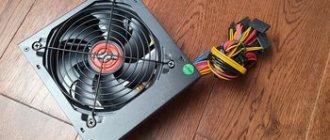| Place | Name | Characteristics in the rating |
| The best interactive UPS |
| 1 | Energy UPS 600 | Best price offer |
| 2 | BASTION TEPLOCOM-100+ | Low noise level |
| 3 | APC by Schneider Electric Back-UPS BX500CI | Compactness and high-quality performance |
| 4 | IPPON Back Power Pro II 600 | Digital display. Fast battery charge |
| 5 | SVEN RT-1000 | Better standby time |
| The best backup UPSs |
| 1 | BASTION TEPLOCOM-250+26 | Durability |
| 2 | by Schneider Electric Back-UPS BC650-RSX761 | Ease of use |
| 3 | CROWN MICRO CMU-1000X | Sound notification. High build quality |
| 4 | Powercom WOW-300 | Best price |
| 5 | ELTENA (INELT) One Station 600 | Compact sizes. Built-in battery |
| Best Double Conversion UPS |
| 1 | Ippon Innova G2 3000 | Best Double Conversion UPS |
| 2 | Powerman Online 1000 Plus | Better protection reliability. Remote control of equipment shutdown |
| 3 | BASTION TEPLOCOM-50+ | Compact form factor |
| 4 | CyberPower OLS3000ERT2U | Simple and intuitive control, versatility of execution |
| 5 | EAST EA901PS | Controlled forced cooling system |
additional characteristics
When purchasing a UPS, you should also consider a number of additional technical characteristics:
- Type of output connectors;
- Availability of cold start function;
- Battery life;
- Possibility of connecting an additional battery or replacing it.
UPS output connectors may differ. They are also an important selection criterion. Some models have IEC320 C13 computer connectors. They are suitable for connecting a system unit and a monitor. However, the router and some modern monitors are connected using a regular European socket. In this regard, many UPSs are equipped with CEE 7 sockets, that is, Euro sockets.
Please note that the number of sockets must be at least equal to the number of connected devices. Some special-purpose uninterruptible power supplies used to create power lines have terminals for connecting linear wires.
To protect servers, the UPS has an interface through which the device can “notify” connected equipment about a power failure. This functionality will help complete work automatically, even in the absence of an operator. Uninterruptible power supplies with an RS-232 or USB interface are connected via an interface cable directly to the protected devices without using a charger; a special application must be running on the latter.
The presence of RJ-11/RJ-45 connectors (usually they leave an IN/OUT pair) allows you to protect telephone and computer networks from impulse noise. The input line is connected to the IN connector, the local line is connected to OUT.
Cold start is designed to start electrical appliances connected to an uninterruptible power supply. In the absence of supply voltage, the UPS plays the role of an autonomous power source.
The battery life is determined by the capacity of the installed battery and the total power of the connected consumer devices. In the characteristics, the manufacturer indicates the duration of operation under certain load conditions. Often the real indicator differs from that used in test conditions. Also, the battery capacity is largely determined by the discharge current. In the case of rapid discharge, in 5-10 minutes, the battery can provide only 20-30% of the declared nominal capacity.
Models designed for long-term battery life often have the ability to connect an additional battery. This allows you to obtain the necessary capacity to maintain the longest battery life. The battery has a limited lifespan and will require replacement over time. If the device is designed for continuous operation, you should pay attention to an uninterruptible power supply with a hot-swappable function, that is, without the need to disconnect from the network.
POWERCOM King Pro KIN-800AP
POWERCOM King Pro KIN-800AP
- a relatively inexpensive, but at the same time extremely reliable uninterruptible power supply that can withstand a maximum load of
800
VA, is well suited for use at home.
Based on the test results, the device ensured system functionality for 32
minutes.
The built-in transformer regulates operation within a given range with deviations not exceeding 15
% from the norm. When these limits are exceeded, the UPS automatically switches to powering the system from the battery. If the surges are less than a specified value, then the autotransformer simply regulates the output voltage, increasing or decreasing it.
Unfortunately, according to the test results, the KIN-800AP demonstrated the longest battery charge time from the mains. It took a full recharge 4
hours
40
minutes. However, normal operation of the device is possible on a significantly lower charge, which is achieved within half an hour after connecting to the network.
In general, this uninterruptible power supply makes a good impression, considering the rather modest price - no more $150
.
“MANIA” RATING: 7/10
About battery life
For any UPS, its data sheet indicates at least the battery life at full power load (usually 3-10 minutes if only internal batteries are used). The operating time at half power is often specified. Some manufacturers provide precise graphs on their websites, from where you can find out the exact number of minutes at the load of interest to the consumer.
The general recommendation is to use a UPS at 0.5-0.75 full power. This allows you to correctly shut down the equipment (unless, of course, we are talking about starting a diesel generator set). This is exactly what gives 5-15 minutes of autonomy.
What to do if you need more battery life:
- use special series of UPSs with more capacious batteries (for example, the name may contain Extended Run);
- use a UPS with the ability to connect external batteries.
In this way, a battery life of several hours can be achieved. What to consider when doing this:
- If the UPS operates at a lower load percentage (e.g. 20-30-50%), then the actual battery life may be longer, but the efficiency will be greatly reduced. For home and simple office applications this is not so important, however, for large installations of tens of kW, efficiency is never neglected;
- A UPS of any design cannot connect to an unlimited number of external battery units. This is because in order to charge the batteries, the UPS circuit must produce charging current. If there are a lot of batteries, then the current increases to some limiting values that the power grid itself can provide. Therefore, in practice, about 10 external battery packs can be connected to a medium-power UPS (1-20 kW) at the level of a telecommunications cabinet. The autonomy time will still remain on the order of several hours. For large UPSs, batteries are usually batteries in special racks or closed cabinets, and their number is selected by special calculations;
- It is not cost effective to maintain a large number of batteries; their average service life is 5 years. There are special series for 10-12 years. Battery life is greatly influenced by environmental conditions;
- a large number of batteries (in any design) means a large mass and dimensions, and the load factor on the floor comes into play, which must be coordinated with the building maintenance service;
- economic calculations carried out by UPS manufacturers show that starting from a certain threshold of autonomy time (taken for a given power level), the total cost of ownership of a UPS + diesel generator system becomes less than the total cost of ownership of a large fleet of batteries.
Voltage regulator
A voltage stabilizer is a device that brings increased or decreased voltage in the network to a normal value. In fact, a stabilizer is a special case of a UPS in which there is no battery and inverter. Sometimes stabilizers also lack filters. Thus, the device protects against only two power supply problems:
- low voltage;
- increased tension.
The use of this device is advisable where voltage loss is not at all a critical factor. Stabilizers for high powers (more than 10-20 kVA) are most often made three-phase, as well as UPSs.
Practical advice when choosing a UPS
Three factors need to be assessed:
- Equipment power consumption.
- Required battery life during a power outage.
- Method of connecting consumers to the UPS.
Rating of the best backup uninterruptible power supplies
Redundant power supplies are best suited for providing backup power to a network where there are no significant voltage surges. On average, the autonomous operation of such devices is 5-10 minutes.
3
Powercom WOW-300
Powercom WOW-300 is a compact backup UPS.
Characteristics:
- Price – 2,374 – 4,228 rubles;
- User rating – 4.3;
- Power – 300 VA / 165 W;
- Input voltage indicator – 165-275V;
- Output connectors – 3.
It is ideal for connecting PCs and home appliances. The device has digital microprocessor control, an automatic frequency detection function, self-diagnosis and battery condition monitoring, short circuit and overvoltage protection, a radio interference and electromagnetic radiation filter. The user can use USB or RS232 connection slots.
Advantages:
- Compact body;
- Low cost;
- AVR;
- Long power cord;
- Possibility of floor or wall installation;
- No setup required;
- Belongs to the lowest price category, good value for money.
Flaws:
- A small number of nests;
- 2 sockets are battery operated;
- Low power;
- Suitable for protection against short-term power outages;
- Flimsy plastic on the body.
2
Powercom SPIDER SPD-1000N
Powercom SPIDER SPD-1000N is a reliable UPS that provides power to connected equipment in the event of a power outage.
Characteristics:
- Price – 4,761 – 6,460 rubles;
- User rating – 4.5;
- Power – 1000 VA / 550 W;
- Input voltage indicator – 220-240V;
- Output connectors – 8.
The battery life is sufficient for correct shutdown and saving of the necessary data. The output power is 1000 VA, which is enough to connect equipment with high energy consumption. When the battery is fully charged, the uninterruptible power supply will provide 20 minutes of operation. Switching to battery power takes no more than 6 minutes. The device has a protection system against overload, short circuit, and input voltage filtering. There are 8 Euro sockets installed on the case.
Advantages:
- Low price;
- Stable work;
- Output voltage;
- LED indication;
- Availability of a protection system.
Flaws:
- Only 4 sockets work from the battery.
1
IPPON Back Verso 800 New
UPS IPPON Back Verso 800 New is suitable for connecting monitors, personal computers, and other equipment.
Characteristics:
- Price – 4,899 to 6,158 rubles;
- User rating – 4.5;
- Power – 800 VA / 420 W;
- Input voltage indicator – 170-270 V;
- Output connectors – 6.
It will provide reliable protection against electromagnetic and radio frequency interference, high-voltage surges, undervoltage, overvoltage or complete shutdown. There are 6 euro sockets on the case: 2 of them are connected from the battery and two more with limited functionality. The latter can be used as a surge filter. There is also a special socket for organizing telephone line protection.
Advantages:
- Low cost;
- Telephone line and network protection;
- Compact body;
- Silent operation;
- Presence of indicators on the body;
- Quick switch to battery.
Flaws:
- 4 battery sockets.
About power
Equipment power consumption can be reported in either Watts (W) or Volt-Amps (VA). In real life, not all the power provided by a UPS is actually consumed by the equipment (load). The active power absorbed by a load (measured in W) is the power doing useful work and is always less than the total power supplied (measured in VA). This ratio is called the load power factor, or Power Factor, PF. Thus PF is always less than one.
PF values for typical load types:
- computer power supplies - 0.6;
- power supplies with simple power factor correction (passive) - 0.7-0.75;
- power supplies with advanced power factor correction (active) - 0.95-0.99;
- electric motors - 0.5-0.8 (depending on the equipment in which the engine operates);
- incandescent lamps and fluorescent lamps - 0.9-1.0.
At the same time, the main characteristic of a UPS is also power. Strictly speaking, the power of a UPS is its output power, that is, the power that it can supply to its output to the consumer. The output power of a UPS is usually indicated in Volt-Amps (VA), in the vast majority of cases this figure is read in its name, for example APC SUA750i, Eaton 5SC 1500i, etc. However, the UPS itself is also an electronic circuit and has its own output power factor. That is why the technical specifications of the UPS indicate two numbers, for example:
- Output power 390W / 620VA
- the example is typical for simple low-power line-interactive UPSs, it can be seen that the output power factor = 0.63 - Output power 8.0 kW / 10.0 kVA
- this example of a high-power online UPS with more complex circuitry, the output power factor is already 0.8.
Thus, we have two load power values and two UPS power values. The simplest procedure for selecting a UPS by power would be that the load power in VA and W should be less than the corresponding power values of the UPS.
However, it should be noted that this is a simplified approach that is 100% suitable for home equipment and for simple enterprise applications (for example, a small office). We simply have known powers and must compare them. For more serious installations, more accurate calculations are required. In this case we mean:
- Increased power consumers are more than 5-10 kVA and can extend up to megavolt-amperes.
- Transition to three-phase power distribution, and as a result, transition to a UPS with a three-phase input and a single-phase output (usually called UPS 3/1), and with powers of 40 kVA and above it will only be a UPS with a three-phase input and three-phase output (UPS 3/3 ).
These calculations should be the topic of a separate article with specific numerical examples. But for simplicity, and without using formulas, the process of selecting a powerful UPS can be described in four stages:
- a complete list of load groups is compiled, for each of which the power is taken into account (either in W or in VA, depending on what is shown in the passports of the relevant equipment) and the power factor of these loads. As a result, the total active power of the load (W) and its apparent power (VA) are calculated.
- a UPS with a total output power value in VA is selected, capable of covering the needs for the full power of consumers (VA);
- it is checked whether the selected UPS is capable of covering the active power requirements of consumers (W), taking into account the specific situation at the facility. It is at this step that it often becomes clear that it is necessary to select the next UPS in the series, for example 60 kVA instead of 48 kVA;
- it is checked again whether the next UPS in the series should be selected due to possible increases in loads in the future, taking into account:
a) possible expansion of the project;
b) transition to a UPS design with redundancy, where additional increasing factors come into play in the calculations.
In addition, it should be noted that when choosing powerful UPSs, the following factors are taken into account:
- Such UPSs often include a power distribution unit, or PDU (traditionally abbreviated as Power Distribution Unit). In fact, this is a distribution cabinet with circuit breakers. If the PDU is not included in the UPS, it must be assembled and installed on site. This is done by contractors in agreement with the person responsible for the electrical equipment of the enterprise. At least for this reason, it is clear that choosing a powerful UPS is always a design work with electrical calculations.
- any UPS (and not only powerful ones), even without a PDU, is equipped with one or more output circuit breakers. From here it is necessary to check whether the selected UPS is able to withstand the inrush currents of consumers. For example, this is very important for variable speed drives. It is necessary either to increase the power of the UPS, or to include in the design devices for limiting inrush currents;
- interface with a generator (or diesel generator set, diesel generator set). This is a separate question, also worthy of a good article with examples of calculations. The interaction between the diesel generator set and the UPS is carried out in a complex cycle. A brief conclusion on this topic is that it is necessary to select the power of the diesel generator set higher than the power of the UPS and at the same time select the power of the UPS as accurately as possible for its load;
- it is necessary not to forget about the UPS’s own efficiency; at high powers this makes significant adjustments to the calculations;
- it is necessary to take into account electrical safety factors, including the high DC voltage that occurs along the path of connecting the UPS and a large array of its external batteries;
- it is necessary to accurately take into account the weight and size characteristics, especially the load on the building’s floors;
- climatic factors must be taken into account. The installation of a powerful UPS is inseparable from the installation of an air conditioning system for its operation, which in itself is a separate design topic.











